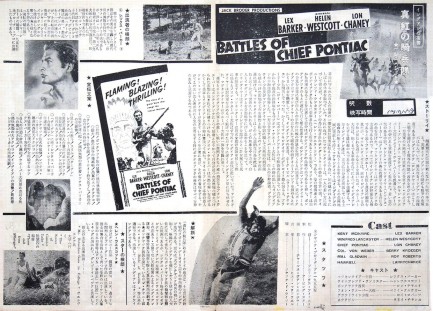 There's never a RoboCop when you need one. 
The city of Detroit recently rejected a statue of the main character from 1987's RoboCop, made by a local artist group and meant to be displayed at the city's Michigan Science Center. Seizing the opportunity, the mayor of Stevens Point, Wisconsin—which is where RoboCop star Peter Weller was born—has offered a place for the statue in the town of 26,000. Mayor Mike Wiza called the artists, as well as Peter Weller's family. in a so-far unsuccessful attempt to secure the figure. The story amused us because, though on the surface the statue seems like a fitting public monument for Weller's hometown, we wonder if Mayor Wiza knows that RoboCop, aside from being a very good movie, is director Paul Verhoeven's dark satire of the U.S.
The movie hits on several areas, including policing and television culture, but most particularly it's a cautionary epic about the power of corporations. It made the prediction, also made by others, that all life would soon be controlled by corporations, and by extension the unelected, megarich heads of those entities. Those who doubt 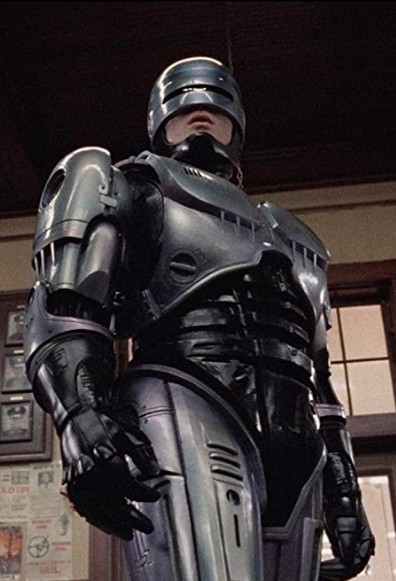 we've reached this point should read up on private prisons, or Citizen's United v. FEC, or Facebook's recent attempt to punish the entire country of Australia by slapping it with a news ban. we've reached this point should read up on private prisons, or Citizen's United v. FEC, or Facebook's recent attempt to punish the entire country of Australia by slapping it with a news ban.
RoboCop goes on to posit that corporations allowed to grow and spread unchecked inevitably make the business decision to place profit above human lives. It didn't mean lives in some distant corner of the globe, or some urban niche of Detroit, where the movie was set. That was already clear. The movie's incisive subtext was that the lives of middle Americans—the very people who live in Stevens Point—would soon be deemed expendable too.
When movies like this pop up they create a paradox: people generally won't watch social critique films unless they're violent and/or funny, but when they're violent and/or funny the majority of people don't get the critiques, even when those are obvious. Examples: Starship Troopers (also a Verhoeven film), Being There (which starred Dr. Strangelove's Peter Sellers), 2019's Us (whose unspoken but glaringly obvious alternative title is, “U.S.”), and, to cite a particularly clear-cut example of blunt satire, They Live, which a substantial minority of filmgoers still managed to think of as merely a strange and slow-moving sci-fi invasion flick.
It's possible Mayor Wiza knows exactly what RoboCop is about, but simply can't pass up the chance to plant something in the town square that will bring gawkers and Instagramers to local restaurants and add warm bodies to the yearly artwalk. If he succeeds, in public he'll hail his coup as an economic victory for his administration (though mainly for the town, always the town first). But later he'll stand at a window in city hall, looking down at RoboCop, nodding thoughtfully as he explains to some nearby aide, “The ironic part of turning that statue into a public monument is that RoboCop, aside from being a very good movie, is director Paul Verhoeven's dark satire of the U.S.” 
 Prosecution maintains that the only way to know if these are in fact the witness's panties is to have her try them on. 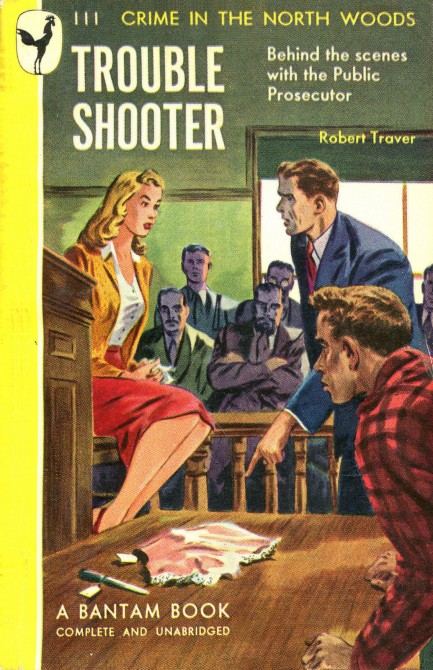
As the great defense attorney Johnny Cochran once so memorably intoned, “If the panties don't fit you must acquit.” Lawyering is all about snappy rhymes. Robert Traver knew this because he was in reality John D. Voelker, first a prosecutor, second a justice on the Michigan Supreme Court, and all the while the author of numerous novels. The most famous of those was Anatomy of a Murder, which became an Otto Preminger motion picture starring Jimmy Stewart and Lee Remick. Looking at the odd cover scene above, you probably want to know what's happening. An assistant prosecutor is trying his first case, which centers around a house painter who “did ravish and carnally know” a young woman named Gloria. But it turns out Gloria's mother had interrupted what was actually a consensual encounter, exploded with shame and outrage, and forced her daughter to file rape charges. The case falls apart in court and the young prosecutor is made to look like a fool, so the cover art tries to capture that event. Trouble Shooter was originally published as Trouble-Shooter: The Story of a Northwoods Prosecutor in 1943, with this Bantam paperback edition coming in 1947.
 Even Hollywood trailblazers get the blues. 
This striking image, which appeared in Esquire magazine in April 1948, shows Maylia, an actress who played Eastern beauties onscreen but was born in Detroit, Michigan as Gloria Chin. Paramount Studios promoted her as “the first Chinese star since Anna May Wong,” and indeed she was—Chinese-American, that is, just like Wong. But in the end Maylia appeared in only six films. In fact she was one of the only Asian actresses appearing in films at all during the the mid-century period. After two years of decent roles from 1947 to 1949, followed by uncredited bits in ’51 and ’53, she left show business to have a family.
 The film stars a Barker—and that's also a good description of this dog. 
This poster, which you will see when you scroll down is two sided, folded into four panels, was made for Battles of Chief Pontiac, a film starring Lex Barker in a story of war between the French and British over what is now the vicinity of Detroit, Michigan. Within this larger fight, Ottawa tribes mount a resistance against the occupying British and their German, or Hessian, mercenaries. This resistance is seriously hampered after the Ottawa are suckered into a peace parlay, then deliberately given blankets infected with smallpox. Treachery much, paleface? Why, yes, all the time.
Throughout all the battles and betrayals hero Lex Barker—the only noble white character—speaks in a neutral American accent that didn't exist 200 years ago, while the supporting white players do their best evil nazi and pompous Brit dialects. This is a nice little trick, portraying all the bad guys as essentially foreign. Never mind that the U.S. is made up of descendents of those colonists, and Barker's character is a colonist too. In cinematic terms it's a deft, almost subliminal job of blame shifting. That the film also showed overseas, where accents would have been lost on audiences, thus making it play more like a broad indictment of colonial expansionism, is an irony. Until we shared today's poster there was never any indication anywhere online that Battles of Chief Pontiac played in Japan, but the evidence is clear in this butterscotch promo—which is far more artistic than the film. Yes, this Barker vehicle is a total dog. Avoid it, except for its comedy potential—that is, if watching pasty white guys in brown shoe polish is funny. Battles of Chief Pontiac premiered in the U.S. today in 1952, and according to the poster, hit Japan in 1956. You see the right half of the front side, and the entire rear just below.
 I'll have both your badges for this outrage. In the meantime, either of you got a condom? 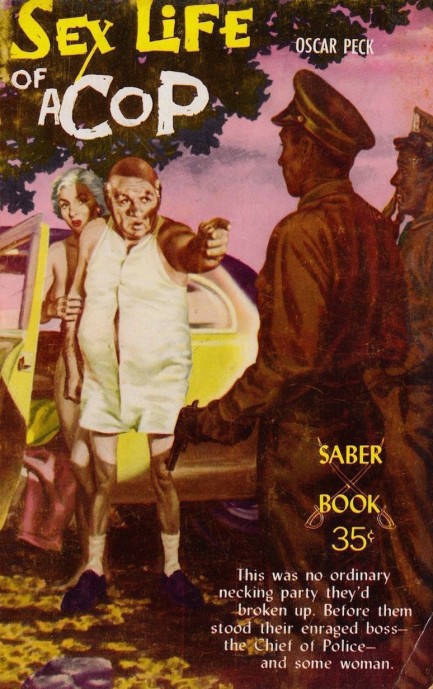 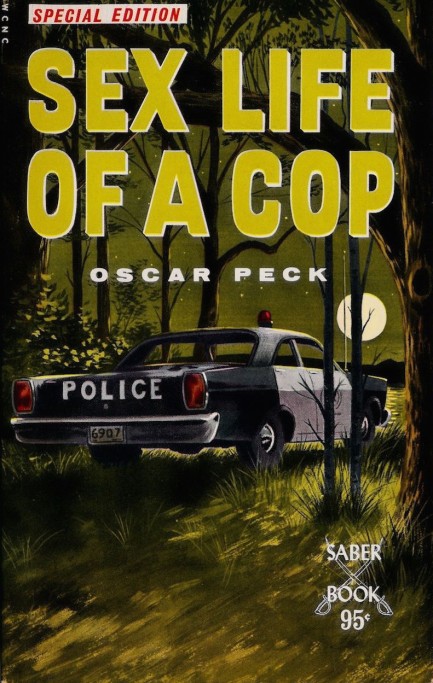
Pretty tame by today's standards, 1959's Sex Life of a Cop is the book that turned into a legal nightmare for publisher Sanford Aday when he shipped copies out of California, was indicted in Arizona, Michigan, and Hawaii in 1961 of interstate trafficking of obscene material, and finally convicted in Michigan in 1963. The story deals with two small town cops named Dempsey and Thorne who give a fat helping of nightstick to any woman whose path they cross, everyone from the hot new dispatcher to a female reporter who goes for a ride along. Ahem. The action starts right on page one outside the police station and doesn't let up. Aday, who was also the author of this as Oscar Peck, earned himself a $25,000 fine and twenty-five years in prison, a sentence that was eventually overturned.
Sex Life of a Cop later caused legal reverberations all the way to the Supreme Court, where it was ruled not obscene in 1967. This was a stroke of good luck for publisher Reuben Sturman (the genius behind It's Happening), because he too was arrested and charged with obscenity when Cleveland police liberated more than 500 copies of the book from his warehouse. The Supreme Court ruling cleared him of wrongdoing. All this for a book that differs little from other sleaze of the era save that it stars two cops. But therein lies the lesson. When you cast aspersions upon law enforcement they'll move heaven and earth to punish you, first amendment be damned. We have covers for the original 1959 edition and the 1967 reprint.
 Actually, you’re drinkin’ the kerosene I use for my lantern. The moonshine’s over yonder. But I am duly impressed. 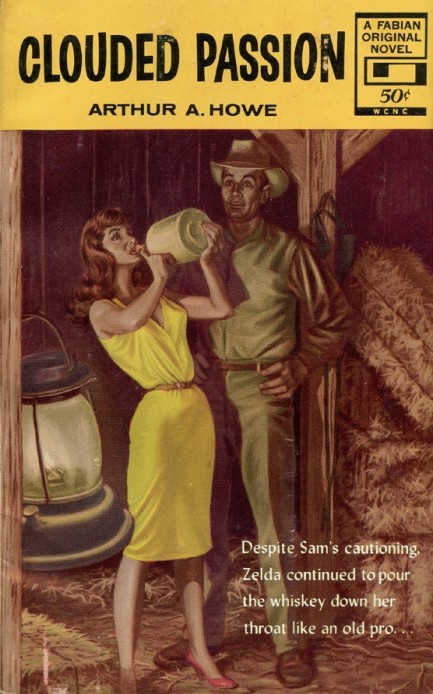
Above, the cover of Clouded Passion by Arthur A. Howe, for Fabian Books, 1962, with Bill Edwards cover art of a country girl chugging booze like a Zeta Tau Alpha. Fabian, as well as Vega Books and Saber Books, was owned by Sanford Aday, who made himself a constant target for various morality groups, including Citizens for Decent Literature, which was headed by that paragon of virtue Charles H. Keating. Aday was eventually convicted of obscenity, along with his associate Wallace de Ortega Maxey, for shipping a single copy of the book Sex Life of a Cop to Michigan. Aday got twenty-five years, but the conviction was overturned by a Supreme Court decision. The novels from Adey’s three publishing houses are somewhat collectible today, and most of the covers were exactly like this one—amusing but low quality. If you’re interested, you can see a group here.
 Just hike the ball and hit somebody. 
Is it Matt Damon? No. The intense person you see here is U.S. president-to-be Gerald R. Ford posing in his Michigan Wolverines uniform circa 1933. Ford was a very good athlete, and in 1934 he won the Wolverines’ Most Valuable Player award. There are plenty of versions on the internet of this shot from a three-quarters angle, but we’re pretty sure this is the first time a head-on has appeared online.
 Heart found sans body—no sign of Edgar Allen Poe. 
In the U.S., in a place called Paw Paw, Michigan, the owner of a manual car wash found a heart inside a wash bay. He called police, who took it to an animal clinic, where a veterinarian could not determine its origin. Next they went to a cardiologist, who said that while the organ was human-sized, he could not conclusively determine its source. Next stop was Lansing, Michigan’s Sparrow Hospital, where CSI techs are set to examine it. Paw Paw police Chief Patrick W. Alspaugh commented: “If it’s a human heart, that prompts the question, then where’s the body?”
|
 |

The headlines that mattered yesteryear.
2003—Hope Dies
Film legend Bob Hope dies of pneumonia two months after celebrating his 100th birthday. 1945—Churchill Given the Sack
In spite of admiring Winston Churchill as a great wartime leader, Britons elect
Clement Attlee the nation's new prime minister in a sweeping victory for the Labour Party over the Conservatives. 1952—Evita Peron Dies
Eva Duarte de Peron, aka Evita, wife of the president of the Argentine Republic, dies from cancer at age 33. Evita had brought the working classes into a position of political power never witnessed before, but was hated by the nation's powerful military class. She is lain to rest in Milan, Italy in a secret grave under a nun's name, but is eventually returned to Argentina for reburial beside her husband in 1974. 1943—Mussolini Calls It Quits
Italian dictator Benito Mussolini steps down as head of the armed forces and the government. It soon becomes clear that Il Duce did not relinquish power voluntarily, but was forced to resign after former Fascist colleagues turned against him. He is later installed by Germany as leader of the Italian Social Republic in the north of the country, but is killed by partisans in 1945.
|

|
|

It's easy. We have an uploader that makes it a snap. Use it to submit your art, text, header, and subhead. Your post can be funny, serious, or anything in between, as long as it's vintage pulp. You'll get a byline and experience the fleeting pride of free authorship. We'll edit your post for typos, but the rest is up to you. Click here to give us your best shot.

|
|























 we've reached this point should read up on private prisons, or Citizen's United v. FEC, or Facebook's recent attempt to punish the entire country of Australia by slapping it with a news ban.
we've reached this point should read up on private prisons, or Citizen's United v. FEC, or Facebook's recent attempt to punish the entire country of Australia by slapping it with a news ban.







